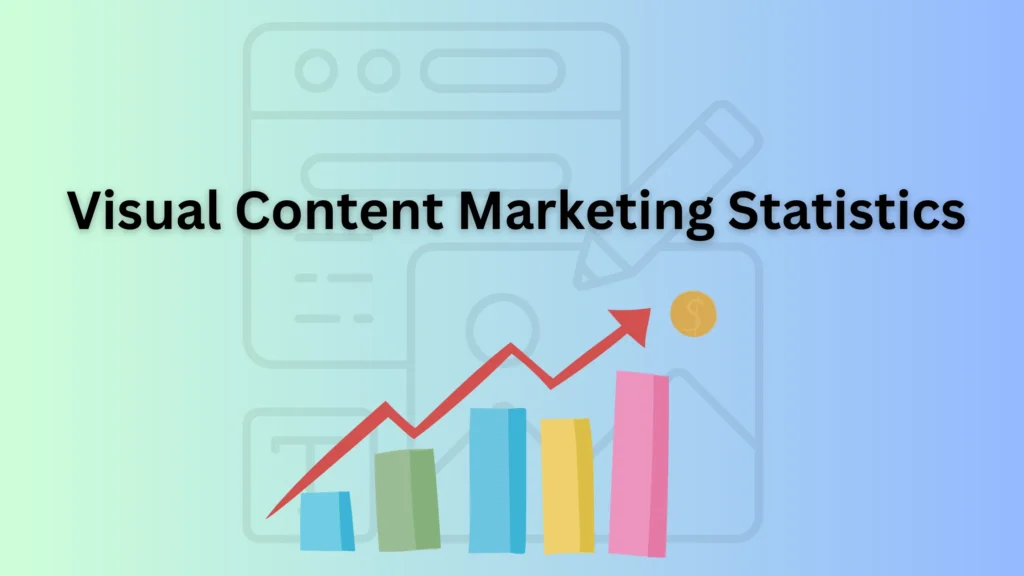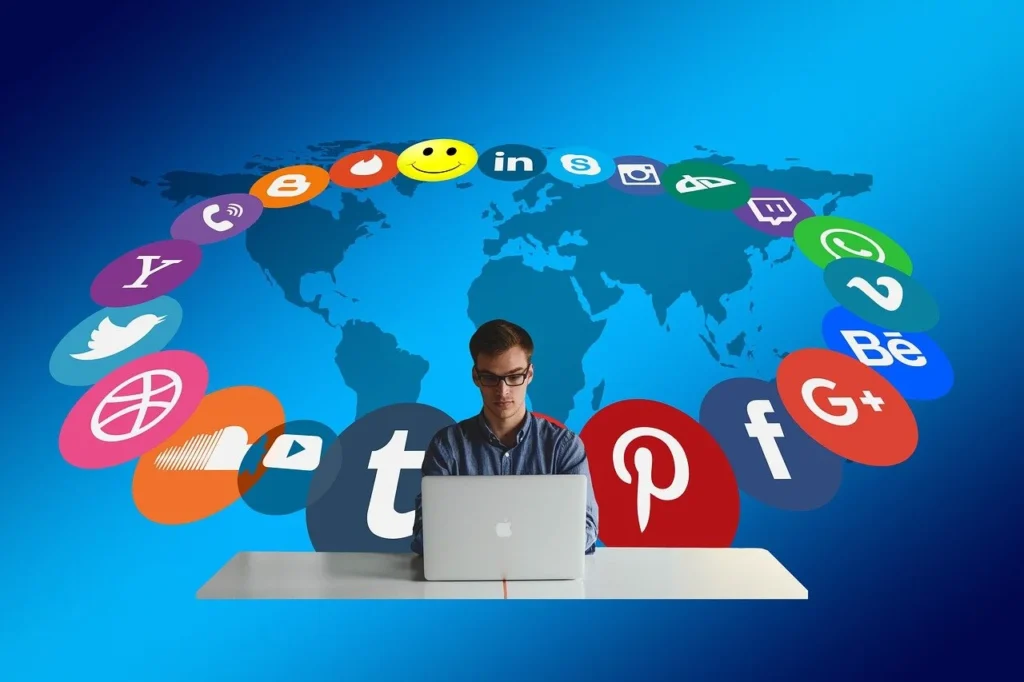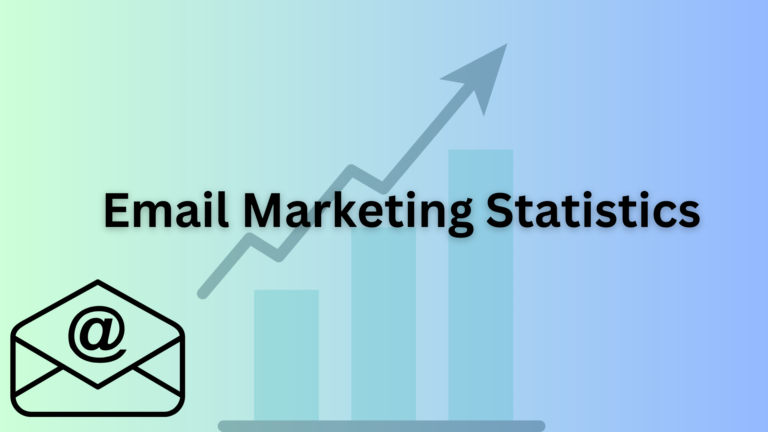Visual content marketing is a smart way to grab attention and connect with people online. From eye-catching images to fun videos, visuals help brands stand out in a busy digital world.
The latest statistics show just how helpful visuals can be in marketing. Whether it’s getting more likes and shares or helping people remember your brand, the numbers speak for themselves.
In this post, we’ll look at the top visual content marketing statistics that show why using visuals really works in 2025.
What Makes Content Visual?
Visual content isn’t just about adding pictures—it’s about helping your audience see the message. It includes images, videos, infographics, charts, and even the way your text is laid out. White space, bold headings, and bullet points all guide the eye.
Visual content grabs attention, breaks up long text, and makes your ideas easier to understand and remember.
In a world full of information, making content visual is how you keep people engaged—and coming back for more.
Benefits of Visual Content Marketing
Visual content is a smart strategy in digital marketing. That is why about 37 percent of marketers make it their main focus. It helps increase organic traffic, encourages social shares, and earns valuable backlinks that boost your SEO.
People are often short on time and prefer content that is quick and easy to understand. Visuals help capture attention, keep your audience interested, and make your message more engaging and easier to follow.
Here are some key benefits of using visual content in your marketing:
1. People Learn Better Visually
Our brains process images much faster than text. That is why platforms like YouTube and Instagram and blog posts with infographics tend to perform better. Research shows that 65 percent of people are visual learners.
Including clear and relevant visuals in your blog or social media content can make it more engaging and effective, especially for educational topics.
2. Easier to Understand
Reading large amounts of plain text can feel overwhelming, especially when the language is complex. Visuals help break down difficult ideas using graphics, charts, and illustrations that make your message easier to understand.
3. Great for eLearning
Visual elements like diagrams, infographics, and charts help make learning more interactive and memorable. They improve focus and simplify the delivery of key information.
Whether you are creating content for social media, a website, or an online course, visuals help you connect with your audience and improve their overall experience.
How can you get better at visual content marketing?
Pay attention to how experienced marketers and creators use visuals to grow their reach and boost engagement. Learn from their techniques and apply those insights to your own strategy.
Up next, explore 60 visual content marketing statistics that will help you design more effective and impactful content.
60 Visual Content Marketing Statistics 2025

General Visual Content Statistics
Visual content continues to play a vital role in modern digital marketing. From boosting engagement to improving information retention, here are the latest stats that prove its value:
Widespread Use of Video Content
- 91% of businesses use video as a marketing tool, the highest percentage recorded since 2016.
- 96% of marketers say video improves user understanding of their product or service.
- 84% of consumers say promotional videos influenced a purchase decision.
- 59% of executives prefer watching a video over reading text.
Engagement and Retention
- Posts with images get 650% more engagement compared to text-only posts.
- Visual content increases retention rates by up to 65% when paired with relevant text.
- Infographics are among the most-shared content formats online.
Learning and Cognitive Processing
- 65% of people are visual learners, making visual formats more effective in communication and learning.
- The human brain can recognize and process images in just 13 milliseconds.
- People process visuals 60,000 times faster than text.
- 40% of learners respond more effectively to visual information than written content.
Emotional Impact and Branding
- Visuals can trigger emotions and create strong emotional connections with viewers.
- Adding animated characters or human figures to visuals helps build brand identity and improve message clarity.
- Visual storytelling is widely used in eLearning to boost engagement and knowledge retention.
Investment in Visual Content
- Video production costs range from $1,200 to $50,000, depending on complexity and production quality.
- 80% of marketers consider visual content essential to their content marketing strategy.
(Source: Shiftelearning, Poll Everywhere, Pepper content, Wyzowl, 2021)
Must-Know Visual Content Marketing Statistics:
Let's read some must-know visual content marketing statistics and present-day market trends.
- 26% of marketers are actively using infographics, with another 15% planning to adopt them soon.
- Articles that include visuals receive 94% more views than those without any images.
- Social media posts with images generate 150% more engagement than text-only posts.
- 91% of marketers use video as a core part of their content strategy.
- 66% of video advertisements are now under 30 seconds to cater to shorter attention spans.
- 84% of consumers say that watching a brand’s video has convinced them to purchase a product or service.
- Infographics are 30 times more likely to be read than plain text content.
- Using infographics can increase website traffic by up to 12%.
- Visual content helps brands connect emotionally with their audience and boosts brand storytelling.
- Investing in high-quality visuals improves user engagement, brand awareness, and conversion rates.
(Source: SAG IPL, Visme)
Statistics of Visual Content Marketing Share
Visual content continues to play a pivotal role in digital marketing, with businesses increasingly integrating various visual elements into their strategies. Recent statistics provide insight into this trend:
- Approximately 91% of businesses are utilizing video as a marketing tool.
- 88% of consumers express a preference for brands to produce more video content.
- 78% of individuals prefer to learn about new products through short video content.
- 93% of marketers plan to allocate the same or increased time to social media marketing.
- 83.2% of content marketers intend to incorporate AI tools into their strategies, marking an 18.5% increase from the previous year.
- The global content marketing industry is projected to reach approximately $1.95 trillion by 2032.
These statistics underscore the growing importance of visual content in engaging audiences and enhancing marketing effectiveness.
(Source: Venngage, Visme)
Statistics of Different Visual Content Forms:
Visual content remains a cornerstone of digital marketing, with various forms offering distinct advantages in engaging audiences. Recent data highlights the effectiveness of different visual content types:
- Video Content: Dominating the content marketing landscape, videos are utilized by 61% of B2B marketers, with 52% expecting increased investment in this medium in 2025.
- Infographics: Ranked as the fourth most used content type, infographics are favored for their ability to distill complex information into engaging visuals.
- Illustrations and Infographics: Combining illustrations with infographics has been shown to enhance engagement by 41.5%, outperforming other visual formats.
- Charts and Visualizations: Holding the second position in engagement metrics, charts and visualizations contribute to a 25.7% engagement rate, aiding in data comprehension.
- Videos and Presentations: These formats collectively achieve a 20.2% engagement rate, highlighting their role in delivering dynamic content.
- Stock Photos: Utilized by 42% of marketers, stock photography remains a popular choice for enhancing visual appeal.
- GIFs and Memes: While less prevalent, GIFs and memes are employed by 5% of marketers, adding a touch of humor and relatability to content.
(Source: Content Marketing Institute – B2B Content Marketing Trends, HubSpot)
Statistics of Content Creators and Visual Content Marketing
Let's learn how content marketers utilize visuals in their content marketing; also, let's look at the expense they spend on generating visuals.
- 56% of marketers utilized visual content in their entire published articles.
- 50% of interviewed marketers reported they invested less than 5 hours every week in 2020 to produce visual content.
- 22% declared they spent 5 to 10 hours creating visuals each week.
- 29% of marketers invested between 10 and 20 hours weekly publishing and designing visual content.
- Marketers invest most of their time in creating content for their company website and Facebook.
- According to visual content stats, 41% of content marketers choose online solutions to generate visual content.
- 18.7% implement upgraded graphic design software
- 27.1% of companies' marketers hire in-house graphic designers to create graphics.
- 16.2% of them still depend on Freelancers.
- 34% of today's marketers report reserving budgets for generating visual content.
- 28% of them use the allocated budget on software and tools.
- 19% of them spend on video creation, only 10% on animation, and 9% on stock photos.
- The difficulty level of creating visual content out of 10: most marketers rate 5 and 8 on the range.
- 36.7% of visual content marketers face serious problems designing, researching, and structuring the data in visual content.
(Source: Venngage, IMPACT+, Pepper Content, HubSpot, Visme, Elite Content Marketer, 2021)
Visual Content Marketing and Human Psychology:
Visual content significantly influences human cognition, learning, and memory retention. Recent studies and statistics underscore the profound impact of visuals on information processing:
- Learning Enhancement: Incorporating visuals can improve learning by up to 400%, stimulating cognitive processes and imagination, leading to faster information absorption.
- Memory Retention: The human brain retains visual information more effectively, with visuals being processed 60,000 times faster than text, and 90% of information transmitted to the brain being visual.
- Rapid Processing: Our eyes can register 36,000 visual messages in an hour, and the brain can comprehend a visual scene in less than 1/10th of a second, highlighting the efficiency of visual processing.
- Learning Preferences: Visual learners can recall 65% of information when paired with relevant images after three days, compared to only 10% retention through auditory learning alone.
- Color Influence: Certain colors and combinations can significantly affect mood, appetite, and sleep patterns, emphasizing the psychological impact of color in visual content.
- Emotional Impact: Visuals with negative connotations can leave a lasting emotional impression, as visual memory is encoded in the brain's medial temporal lobe.
Incorporating compelling and strategically designed visual content not only captures attention but also enhances user engagement, learning, and conversion rates, ultimately influencing consumer behavior and decision-making processes.
(Source: Brain Rules, Shiftelearning, Smart Insights, PR Daily)
Statistics of Visual Content and Company:
Visual content has become a pivotal element in companies' marketing strategies across various industries. Recent statistics from 2025 highlight the significant role of visuals in content marketing:
- Video Content Investment: Approximately 61% of B2B marketers anticipate increasing their investment in video content in 2025.
- Infographic Usage: The utilization of infographics has seen a notable rise, with 67% of B2B marketers incorporating them into their content strategies over the past four years.
- Effectiveness of Visual Content: Around 54% of organizations report achieving a moderate level of success with their content marketing efforts, attributing this success to the integration of visual elements.
- Customer Acquisition through Video: Nearly 93% of companies have acquired new customers after sharing video content on social media platforms, underscoring the persuasive power of videos in attracting potential clients.
- Challenges in Visual Content Creation: Approximately 50% of marketers face difficulties in selecting appropriate design layouts for presenting data, statistics, or textual content, indicating a need for improved design strategies.
(Source: Cision PR Newswire, Venngage, Content Marketing Institute, Finances Online)
Statistics of Visual Content and Social Media:

- Around 62% of all internet users are now social media users in 2025, up from 59%. This means more people are online and active on platforms, giving marketers a bigger audience to target with visuals.
- About 85% of marketers now use visuals in their social media campaigns, up from 8 out of 10. Visuals are a must-have to catch attention and drive sales.
- Roughly 20% of marketers create visual content for Facebook, 15% for Instagram, and 13% for LinkedIn. Another 7% focus on visuals for printed materials and branding, showing a slight shift as social platforms dominate.
- Twitter users watch 92% of the platform’s video content on mobile devices in 2025, up from 90%, with only 8% viewing on desktops. Mobile is king for video consumption.
- Around 65% of digital marketers used live video in 2025, compared to 57% in 2019. Live video is booming because it connects with audiences instantly.
- Facebook Live videos now generate 12 times more engagement than pre-recorded videos, up from 10 times, making it a top choice for interaction.
- After studying over 300 people in 2025, 72% say they watch Facebook Stories more often than Snapchat or Instagram Stories, up from 70%. Facebook Stories are winning the short-content game.
- Tweets with video saw 12 times more engagement than those without in 2025, up from 10 times. Video is a game-changer for Twitter users.
- Posts with images on Facebook get 2.5 times more engagement than text-only posts, up from 2.3 times. Pictures are key to standing out in the feed.
- About 18% of all Facebook content is now video, up from 15%, and this number keeps climbing as users crave more dynamic posts.
- Visual content increases social shares and exposure by 40% on average, helping brands reach more people and spark conversations.
- Including a photo URL in a tweet boosts retweets by 40% in 2025, up from 35%. A simple picture can make a tweet spread further.
- The best Facebook videos for engagement are between 2 and 4 minutes long now, slightly shorter than the previous 2 to 5 minutes, as attention spans tighten.
(Source: Venngage, Social Media Examiner, Finances Online, BloggingX, MarketingDigiBook, HubSpot, Twitter Business, and Socialinsider)
Visual Content Marketing and Website:
Visual content plays a pivotal role in enhancing website traffic, user engagement, and brand recognition. Recent statistics from 2025 shed light on its effectiveness:
- Approximately 36% of marketers prioritize creating visuals for blog posts, while 12.7% focus on landing pages.
- Articles featuring images every 75 to 100 words receive double the social media shares compared to those with fewer images.
- Nearly 49% of marketers utilize visuals on blogs and websites, following social channels like Facebook and Instagram.
- Articles or blogs containing visuals garner 94% more total views than those without.
(Source: Buzzsumo, PR daily, Venngage)
Visual Content Marketing and Consumers:
- Approximately 96% of online customers watch videos before purchasing a product or service, highlighting the importance of video content in the decision-making process.
- Around 91% of viewers prefer visual content over text-based content, indicating a strong consumer inclination toward images, videos, and infographics.
- About 85% of internet users consume content across multiple devices simultaneously, emphasizing the need for responsive and adaptable visual content strategies.
- Approximately 69% of viewers watch online videos without sound, suggesting that incorporating captions or text overlays can enhance engagement.
- Around 86% of buyers express a desire for on-demand access to visual content, such as videos and interactive images, to facilitate informed purchasing decisions.
Sources: Sprout Social, WebFX)
Statistics of Visual Content Marketing and Countries
- Over 72 million people in the USA use Augmented Reality (AR) at least once a month in 2025, up from 68.7 million, as AR becomes more common in shopping, gaming, and social media.
Source: eMarketer - Around 45 million people in the USA are predicted to use Virtual Reality (VR) monthly in 2025, up from 42.9 million, driven by affordable VR headsets and immersive entertainment.
Source: eMarketer - About 87% of internet users in the USA watch online videos, according to updated trends from ComScore via eMarketer. This rise from 85% shows how video continues to dominate over static images for grabbing attention.
Source: eMarketer - Approximately 82% of UK internet users engage with online video content monthly in 2025, with brands using short videos and infographics to boost interaction on platforms like YouTube and TikTok.
Source: eMarketer - Around 78% of internet users in China prefer visual content like videos and AR experiences over text-based marketing, fueled by the massive growth of platforms like Douyin (TikTok’s Chinese version).
Source: Visme - Over 65% of India’s social media users (around 350 million people) regularly engaged with visual content such as videos and infographics, in 2025, as marketers tapped into the country’s booming digital population.
Source: eMarketer - About 25 million people in Germany used AR monthly in 2025, with businesses leveraging it for virtual product trials and interactive ads, reflecting Europe’s steady embrace of visual tech.
Source: eMarketer - Roughly 70% of Japanese internet users watch branded video content online, with a focus on high-quality visuals and animations that align with the country’s strong visual culture.
Source: Visme - Around 55% of Brazilian marketers report using infographics in their campaigns in 2025, as they balance video with static visuals to educate and engage a growing digital audience.
Source: Visme - About 80% of Australian internet users say visual content (videos, AR, or infographics) influences their buying decisions more than text alone, pushing brands to invest in creative visuals.
Source: eMarketer
(Source: eMarketer, Visme)
More Latest Statistics to take a look at:
- Essential Instagram Statistics Marketers Should Know
- Google Search Statistics: Key Facts and Trends✅
- Semrush Statistics: Latest Facts About a Big SEO Tool🚀
- Affiliate Marketing Statistics You Should Know
- Latest Social Media Marketing Statistics
In Conclusion
Visual content marketing is a must in 2025. From videos to infographics, visuals grab attention, boost engagement, and drive purchasing decisions. Marketers are using visuals more on social media and websites to increase traffic and build brand recognition.
Investing in quality visuals helps businesses connect with their audience and improve conversions. As consumers shift toward visual content, staying ahead of this trend is key to success.
That's it to wrap up! Hope this gives you the idea. Any questions? Feel free to ask in the comments!







